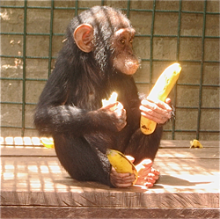
 |
Digestive SystemMost primates are nearly or exclusively herbivores, but their digestive tract does not show the high degree of morphological specialization seen in many other herbivores. The digestive system of Chimpanzees and mammals is made of the alimentary canal and the different accessory glands that hide digestive fluids in the canal and through the ducts. The digestive track has a wall with four layers. First is the lumen, the cavity, is lined by a mucous membrane, the mucosa. Then comes the layer of connective tissue, which is followed by the smooth muscle. Lastly comes the outer most layer which is a sheath of connective tissue that is attached to the membrane of the body cavity. There are schincters that regulate the passage of the food between the chambers of the canal. Starting off of the digestive system is with the oral cavity. The sensation of food in the oral cavity sends a reflex that triggers the salivary glands that send saliva through ducts to the oral cavity. Saliva can appear in the oral cavity before food is there because it is in anticipation. Next, the pharynx is in the throat, intersecting the windpipe and esophagus. Once people swallow, the top of the trachea, which is the windpipe, is closed off by the cartilaginous flap called the epiglottis. This action that is performed prevents food or liquid from entering the windpipe. The esophagus then moves the food from the pharynx down to the stomach. At the top of the esphagus there are muscles, and those muscles are striated. So, the start of actually swallowing is voluntary, yet involuntary waves of contractions happen uncontrollably by the smooth muscles. The saliva continues to hydrolyze starch and glycogen as the food goes through the esophagus. Although some of digestion occurs in the oral cavity and stomach, the majority of it takes place in the small intestine. The pancreas, liver, and gallbladder are also part of the digestion process. The pancreas is what makes several hydrolytic enzymes and an alkaline solution. The liver has a variety of different roles, and one of them is to produce bile. The small intestine contains the duodenum in the first twenty-five centimeters. This is where the digestive fluid from the pancreas, liver, gallbladder, and gland cell from the wall of the intestine mix with the acid chyme that seeps from the stomach. The large intestine or colon is attached to the small intestine and also plays a role in digestion. The major function of the colon is to reabsorb water that has entered the alimentary canal. The colon finishes up the work by reclaiming the water that has stayed in the lumen. The final phase of the digestive system is when the feces reach the terminal part of the colon called the rectum. This is where the feces are stored until they are eliminated. |